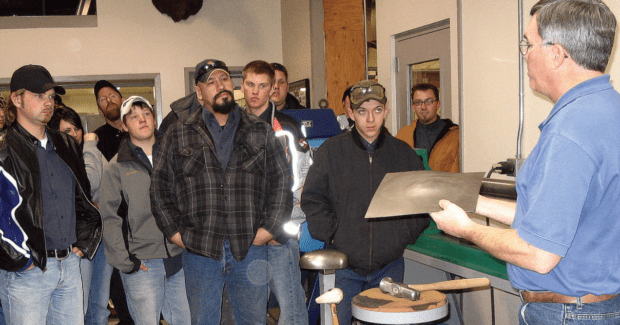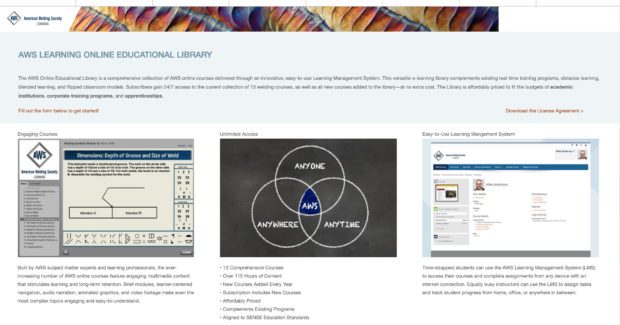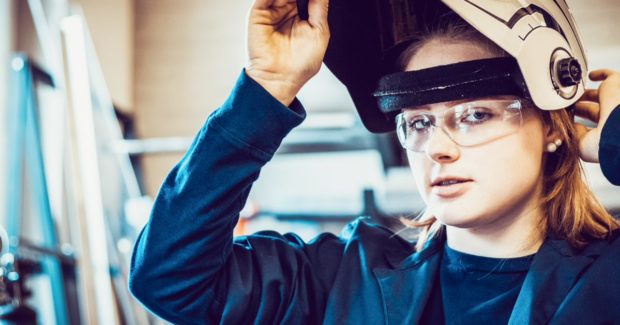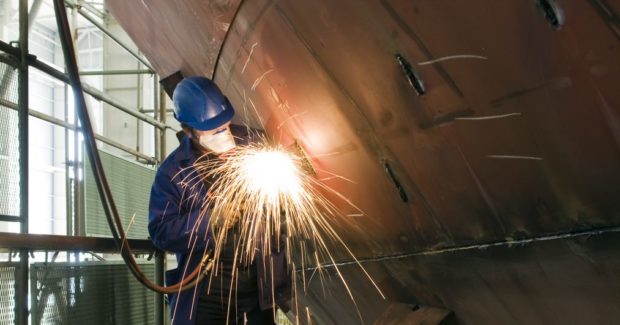Welding’s Digital Transformations, Lucrative Occupations
Deemed essential, welding and the related fabricating and metalworking trades weathered the COVID-19 disruption better than other industries, says American Welding Society Executive Director Gary Konarska II. Demand for skilled tradespeople remains high.
Posted: November 30, 2020
BY GARY KONARSKA
If any manufacturer hadn’t begun its digital transformation before COVID-19 disrupted the world, they probably have now. Fortunately, the American Welding Society (AWS) had already initiated its digital journey, providing 70,000 members in 22 districts consisting of 250 sections and student chapters with a better experience while protecting their health and safety.
For those who want to learn remotely, we offer scores of online courses that provide an immersive experience by incorporating animated graphics, audio narration, video footage and interactive elements that make complex topics engaging and easy to understand. Offerings include everything from an 80-hour Certified Welding Inspector (CWI) preparation course to metallurgy to welding safety (which is free).
The AWS Online Educational Library (eLibrary) complements real-time training programs, distance learning, blended learning and flipped classroom models. In late 2019, we launched the AWS Fundamentals of Welding Curriculum to help instructors at high schools and technical colleges deliver information in an effective and structured manner.
The AWS Member Network includes multiple online forums that allow members to reach out to other members around the world to ask technical questions, share ideas and best practices, get career advice and obtain guidance on just about any matter.
We recently added a hybrid, virtual component to section meetings. Attending a virtual or in-person section meeting is a good way to get to know AWS and to build a network of industry peers. Section members are representatives from local industries, job shops, educational facilities, distributors and students. While there’s a meaningful social component, serious education takes place. For example, I recently participated in a section meeting where we spent more than 30 minutes going through changes in the new 2020 edition of AWS D1.1 Structural Welding Code – Steel, which is the first standard produced by AWS and still the most widely used in our industry.
I mention the meetings and the standards for two reasons. AWS is best known for being the U.S. organization that creates the standards that bring quality, safety and synchronicity to our industry. Second, the local section meetings and our more than 200 technical committees that develop and maintain 300+ standards rely on volunteers who collectively donate hundreds of thousands of hours annually. We are essentially a large group of volunteers that give back to, and help grow, the welding community.
Welding is a Much-Needed and Potentially Lucrative Calling
Certainty is a rare commodity during this time of disruption, but the long-term assurance that comes from a welding-related career is about as close as it comes. First, AWS predicts a shortage of 375,000 skilled welding professionals by 2023. Even now, “Help Wanted: Welder” signs populate industrial parks. Next, because the federal and state governments listed manufacturing, construction and other skilled trade jobs as essential, more workers in these industries have been able to continue their jobs and maintain more work hours compared to other sectors.
Even before the pandemic, the career choice pendulum had started to swing toward the trades. Looking at the research from about a decade ago compared to now, the number of students enrolled in some type of welding program has grown from about 90,000 to 190,000; and the number completing programs grew from around 43,000 to about 100,000. (Source Weld-Ed, 2018)
That has been partly driven by the skyrocketing cost and diminished return of non-science, technology, engineering and math (STEM)- and business-based college degrees. In some instances, welding industry salaries surpass the income-making ability of careers requiring higher education degrees. Furthermore, starting out as a welder offers a myriad of options as your career progresses.
For example, becoming a Certified Welding Inspector (CWI) often leads to positions where the CWI helps a manufacturer develop and document welding procedures. Some CWIs start their own welding inspection businesses. Others take their talents overseas, where the AWS CWI is also accepted. After gaining experience, becoming a Senior CWI opens still more opportunities, and it’s a pretty exclusive club. The type of technical learning AWS offers helps people build a solid foundation and then stack skill sets. They become more attractive to employers, and their businesses flourish because of their reputable credentials.
Once a welder starts learning new skills, getting AWS-certified establishes that the welder has the knowledge, skills and abilities in the principles, processes and equipment to fulfill the responsibilities of that credential. Becoming certified opens up more job and career possibilities. In a classic example, as construction and field applications embraced flux cored arc welding (FCAW), those who demonstrated proficiency with FCAW had more job opportunities than those who had only mastered shielded metal arc welding (SMAW). Note that becoming a Certified Welder is a portable certificate for the individual, enabling geographic mobility.
As for which specific skills to acquire, consider regional differences. For example, the Gulf Coast has heavy employment in the energy and shipbuilding segments, the West Coast emphasizes aerospace, Michigan and Tennessee feature automotive companies, while the Midwest and Upper Midwest are home to agricultural and construction equipment producers. Each industry emphasizes different processes, such as FCAW for structural steel, gas tungsten arc welding (GTAW) and additive manufacturing/thermal spray for aerospace, resistance welding for automotive, automated gas metal arc welding (GMAW) for yellow goods, and automated submerged arc welding (SAW) for ships and liquid natural gas (LNG) tanks.
Speaking of automation, I believe automation creates more jobs in the welding industry than it replaces. We need automation because it makes the skilled workers we have more productive, and that helps level the playing field when competing internationally. In addition, automation makes jobs more attractive. Who wouldn’t want a cobot helping to lift or position a hot part? Also, automation changes the nature of the jobs. Becoming a robot operator, programmer or repair technician is one of the hottest careers around. Based on my nearly two decades of automation experience, it’s a lot easier for a welder to learn to program a robot than it is for a programmer to learn to weld.
In the realm of digital advances, Industry 4.0 is opening doors to new data-crunching careers. Now that advanced welding systems come with built-in or optional connectivity (and manufacturers offer accompanying online analytic tools), the biggest barrier to adoption is the skills gap between data collection and reapplying data to optimize manufacturing practices. For someone who understands welding processes and technical variables — and who can also manage digital information — there’s a huge opportunity to become a change agent.
Expanding Membership Options for Individuals and Companies
One of the best ways to explore careers and jobs available in your area is to become an AWS member and participate in your local section meeting or join a student chapter. You’ll find the members incredibly welcoming and responsive.
Student membership costs $15; regular individual membership costs $88 plus a one-time $12 initiation fee. Benefits include access to the Member Forum, our monthly publication The Welding Journal, the ability to participate on a technical committee and discounts on our certification exams, instructor-led or online courses and other products. We have several levels of corporate memberships, with the best value going to Sustaining members because they can choose to access the AWS Standards eLibrary or get 10 additional individual memberships added to their roster. Annual dues for new Domestic Sustaining Company Members are $880, plus a $750 initiation fee.
Given the social distancing we’ve endured, the ability to meet and connect with people who have common interests is more important than ever. AWS could have many more than 70,000 members if more people involved in our community realized the benefits.









